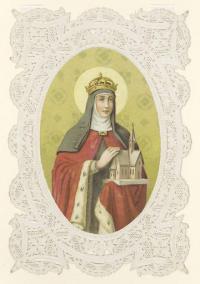
Feast day: 16 October
St Hedwig was the daughter of Berthold of Andechs, margrave of Carniola and Istria, and his second wife Agnes of Wettin. She was born at Andechs Castle in the Duchy of Bavaria in 1174. Some of her siblings married into European royalty and two of her brothers became bishops. She was educated in the Benedictine Abbey of Kitzingen in Franconia, where her youngest sister became abbess.
At the age of twelve, Hedwig married Henry I, the Bearded, son and heir of the Piast duke Boleslaus the Tall of Silesia. In 1202 he succeeded his father as Duke of Silesia. His mother was German, he had been educated in Germany and through his wife he had still closer relationships with Germany. He had many conflicts with his relatives and nearly lost his life on one occasion. However he worked energetically, expanded his realm and established his authority. Under his civilizing influence, Silesia became German in language and customs (today Silesia is mostly Polish but there are parts of it in the Czech Republic and Germany).
Hedwig supported her husband in the administration of his lands. She was prudent, courageous and pious. She gave her support to new monastic foundations and assisted those that were already established. It was through the monasteries that German civilization spread through Silesia. Henry and Hedwig generously endowed the Cistercian monastery of Leubus, the Premonstratention monastery of St Vincent, the foundations of the Canons of St Augustine at Breslau and other religious institutions. The Franciscans,Dominicans and Templars were also brought in.
Hedwig tended the leper women in the hospital at Neumarkt. The convent of the Cistercian nuns at Trebnitz was financed by Henry at the instigation of his wife and was the first house of religious women in Silesia. Later their daughter Gertrude became abbess.
For some time after her marriage, Hedwig lived mainly in Breslau. She had seven children. Three died at an early age. Henry succeeded to his father’s title; Conrad died from a fall from his horse. After her last child was born Hedwig and Henry took a vow of chastity before the Bishop of Breslau. The Duke took the tonsure and allowed his beard to grow. Hedwig spent much of her time after this in the Abbey of Trebnitz, where on the death of her husband in 1238 she began to live permanently. She transferred her inheritance to the abbey.
Apart from the deaths of her children, Hedwig had many misfortunes, including an attack on her husband by the Duke of Pomerania in 1227. Henry was badly wounded and Hedwig hastened to Gonsawa to take care of him. He was then taken prisoner in a conflict over the possession of Cracow and it was Hedwig’s appeal that led to his release. Only Hedwig’s daughter, the Abbess Gertrude, survived her. Her son, Henry II, died in 1142 in a battle against the Tartars.
After her husband’s death, Hedwig wore the grey habit of the Cistercians, but did not become a religious so that she might retain the right to spend her money on charities. She practised severe mortification, cared for the sick and supported the poor.
Hedwig died in 1243 and was buried in Trebnitz Abbey, where her husband Henry was also interred. She was canonised in 1267 by Pope Clement IV, a supporter of the Cistercian Order, at the suggestion of her grandson, the Prince Archbishop of Salzburg.
In 1773 the Prussian King Frederick the Great, having conquered most of Silesia, had St Hedwig’s built for the Catholic Upper Silesian immigrants. It is now the cathedral of the Catholic diocese of Berlin. In 2020, St Hedwig’s remains - which had been missing for centuries - were rediscovered in her sanctuary at Trebnitz, in a silver casket, bearing a lead tablet with an inscription confirming Hedwig’s identity.
St Hedwig, pray for us.